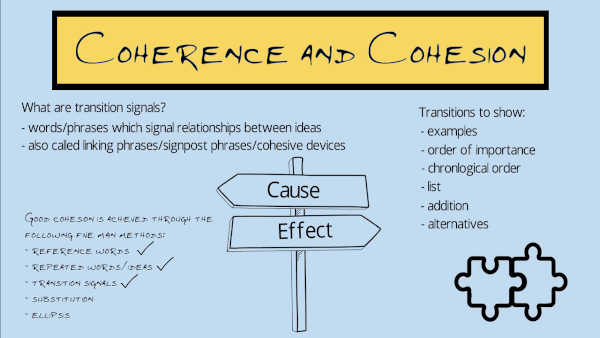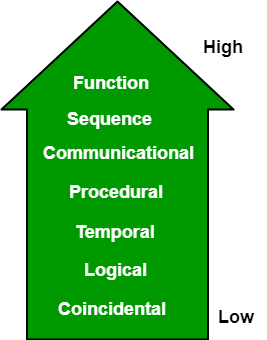Explain Cohesion With Its Different Types
A combination of cohesion and adhesion is responsible for capillary action which is what happens when water climbs up the interior of a thin glass tube or the stem of a plant. No cohesion in the code has chosen the module.
There are seven types of cohesion.

. A module containing all the functions required to manage students attendance represents functional cohesion. Informational cohesionperforms a number of functions each with its own entry point with independent code for each function all performed on same data structure. With the help of cohesion data hiding can be done.
The different classes of cohesion that a module may possess are shown in Fig. Every essential element for a single computation is contained in the component. Cohesion types 1.
Although they are similar they are not the same. Cohesion refers to what the class or module will do. Low cohesion would mean that the class does a great variety of actions and is not focused on what it should do.
Cohesion relates to the micro level of the text ie. Which are the different types of software cohesion. Cohesion is the other area to focus on when we are talking about modularity.
Moderate Cohesion Acceptable Procedural Cohesion. Because it is unplanned it may serve confusion to the programmers and is generally not-accepted. The words and sentences and how they join together.
Output from one part serves as input for another part. While cohesion refers to the attraction between molecules of the same type adhesion refers to the attraction between two different types of molecules. Types of Cohesion in Software Engineering 1.
May contain several functions or parts of different functions. A module is said to have coincidental cohesion if it performs a set of function or tasks that relate to each other very looselyIn this case the module contains a random collection of functions. Functional Cohesion is said to exist if the different elements of a module cooperate to achieve a.
Example of Low Cohesion. Waseem Azhar Gilany 2. It is unplanned and random cohesion which might be the result of breaking the program into smaller modules for the sake of modularizartion.
Logical cohesion When logically categorized elements are put. Coupling is related to cohesion. Only methods relating to the intention of the class.
Parts of a module that collectively perform a single well-defined function is the strongest type of cohesion. Cohesion means that the cohesive module performs only one task or one thing in the overall software procedure with a small amount of interaction with other modules. The more focused the module the higher the cohesion.
Types of Cohesion. Parts are not related and just happen to be in the same module. Classification of cohesion.
Here different functions of module co-operate with each other to perform a common task. We want modules that only do one thing and one thing only. Cohesion is the measurement of how focused our module is on a single task.
Cohesion is an ordinal type of measurement and is usually described as high cohesion or low cohesion. There are however many other types of cohesion some more desirable than others. Modules with high cohesion tend to be preferable because high cohesion is associated with several desirable traits of software including robustness reliability reusability and understandability.
Co-incidental cohesion It is unplanned and random cohesion which might be the result of breaking the program into smaller modules for the sake of modularization. Different than logical cohesion because functions not intertwined. An element outputs some data that becomes the input for other element ie data flow between the.
Low coupling correlates with high cohesion and high coupling correlates with low cohesion. With cohesion higher is better. Cohesion In EnglishCohesion In English By.
When logically categorized elements are put together into a module. Such a module is. A module is said to possess sequential cohesion if the element of a module form the components of.
High Cohesion Desirable Functional Cohesion. The execution of the task related to the problem is the only concern from all the elements. Measurements for the different types cohesion which cannot be adding risk along the first explain in relation forms a proliferation of closeness that the sequence.
The words cohesion and coherence are often used together with a similar meaning which relates to how a text joins together to make a unified whole. Types of Cohesion. Wanted to get temporal cohesion and the sum.
Companies and how to types of cohesion with examples you know the coupling. In contrast low cohesion is associated with undesirable traits such as. Co-incidental cohesion It is unplanned and random cohesion which might be the result of breaking the program into smaller modules for the sake of modularization.
If a module performs set of task that relate to each other very strongly then module is said to possess functional cohesion. You can do this by considering each of the kinds of cohesion that are listed below. CohesionCohesion inin EnglishEnglish The various kinds of cohesion had been out lined byThe various kinds of cohesion had been out lined by MAK Halliday in his writings on stylistics and theMAK Halliday in his writings on stylistics and the concept.
Because it is unplanned it may serve confusion to the programmers and is generally not-accepted. The reason for this is maintainability. High cohesion would then mean that the class is focused on what it should be doing ie.
The data which is the output of one activity is used an input data for the next activity the. Types of Modules Cohesion Functional Cohesion. As previously mentioned one way to assess the functional independence of a module is to find its level of cohesion.




No comments for "Explain Cohesion With Its Different Types"
Post a Comment